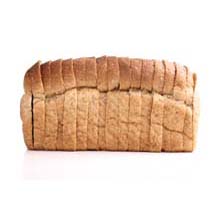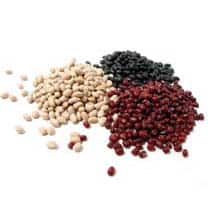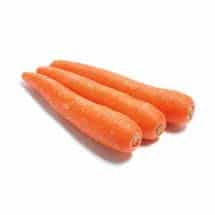Carbohydrates include sugars, starches and fiber. Sugars are simple carbohydrates and starches and fiber are complex carbohydrates. In general, you should consume more complex carbohydrates and eat fewer simple carbohydrates. Um, so how does this translate into which foods are best?
In my last blog, I mentioned the more nutritious foods that have simple carbohydrates that are important to include in a healthy diet: fruits, and low-fat and fat-free milk and dairy foods.
Where this gets complex is that many starchy foods have been stripped of their nutrients either during processing or during food preparation and cooking. We’ve become a nation that abhors the texture and flavor of whole grains and whole foods, in favor of processed or ‘refined’ foods where the hull, bran, germ, skins, seeds, etc. have been removed.
For example, let’s take wheat bread. Many people are surprised to find that white bread is actually made from wheat. White bread is made from refined wheat flour that has had the original parts of the whole wheat grain, the bran and the germ, removed and the resulting bread is made just from the starch and is white, squishy and tasteless. Where the problem comes in is that many of the nutrients from the grain, including vitamins, minerals and fiber, are found in the bran and the germ.
The starch imparts mainly calories, which is why the Food and Drug Administration (FDA) has been regulating the enrichment of white flour with thiamin, riboflavin, folate, niacin and iron for many years. While this enrichment is helpful, it does not come close to replacing the nutrients lost from the original whole wheat grain during processing. The best breads to choose are those that state 100% whole wheat or 100% whole grain on the package and state whole wheat or a whole grain first in the list of ingredients.
Chemically speaking, complex carbohydrates are chains of at least three glucose molecules linked together called polysaccharides (meaning three or more sugars). Starches are long and sometimes branched chains of polysaccharides. Foods containing starch include dried beans and peas (legumes), vegetables, and whole grains such as pasta, rice, cereals and breads.
Choosing the right foods
The most nutritious complex carbohydrates to choose are those that have been processed the least and include vegetables, legumes and grains that have been kept WHOLE – including whole wheat, whole white wheat, whole corn, whole oat, oatmeal, whole rye, buckwheat or kasha, brown rice, quinoa, bulgur, millet, spelt, etc. Also look for pastas and cereals that are made with whole wheat or whole grains. It’s easy to find these foods, since they’ll be marked with Guiding Stars. The Dietary Guidelines for Americans recommend that at least half of the grains you eat be whole grains and for adults this should be a minimum of three servings each day.
Fiber is another complex carbohydrate that is made up of polysaccharides that are linked together by bonds that can’t be broken apart by human digestion. Fiber gives plants their structure and crunch so I like to think of fiber as “plant bones.” Fiber is found in whole grains, nuts, seeds, dried beans and peas, and fruits and vegetables. The edible skins of fruits and starchy vegetables are a great source of fiber and many vitamins and minerals.
Avoid peeling potatoes, carrots, apples, cucumbers, zucchini, etc. and instead enjoy eating the skins after washing and cooking. Although we do not break down fiber and use it for energy, foods high in fiber have a positive impact on our health by reducing the risk of cardiovascular disease, creating a feeling of fullness, stabilizing blood sugar levels, helping to maintain a healthy weight, and supporting healthy digestion.
CONSUMER ALERT – some manufacturers are using refined or processed grains in cereals and other foods and then adding shorter chain functional fibers such as polydextrose and maltodextrin to boost the fiber content on the Nutrition Facts label. For the best health benefits, be sure to look for whole grains.
My intention with these last two blog posts in my Nutrition For Life series has been to share the importance of carbohydrates in your diet and publish examples of the most nutritious simple and complex carbohydrates. Remember, carbohydrates are ubiquitous in your diet and it would be really difficult to be healthy and be on a low carb diet.
Instead, choose fruits, vegetables, milk and dairy foods, dried beans and peas (legumes), nuts and grains including breads, cereals, rice and pastas that get stars. Simply put, these foods and beverages are the super stars in your diet! Next week – we’ll explore protein.
Looking for delicious whole grain recipe ideas? Check out these tips from our Expert Chef: Whole Food: The New Convenience Food
About our Nutrition Expert
Lori Kaley MS, RD, LD, MSB is a member of the Guiding Stars Scientific Advisory Panel. Lori has 30 years of combined experience working in healthcare and public health creating policies and environments to help families and children have access to healthy foods and beverages. She is currently Policy Associate at the University of Southern Maine’s Muskie School of Public Service.
Lori’s greatest achievement and joy has been in raising her three daughters to be healthy and productive young adults, each with their own particular love of food, cooking and being physically active. Lori’s passion for nutritional community outreach has been a cornerstone of the Guiding Stars Scientific Advisory Panel. Lori regularly contributes to the Guiding Stars blog.



